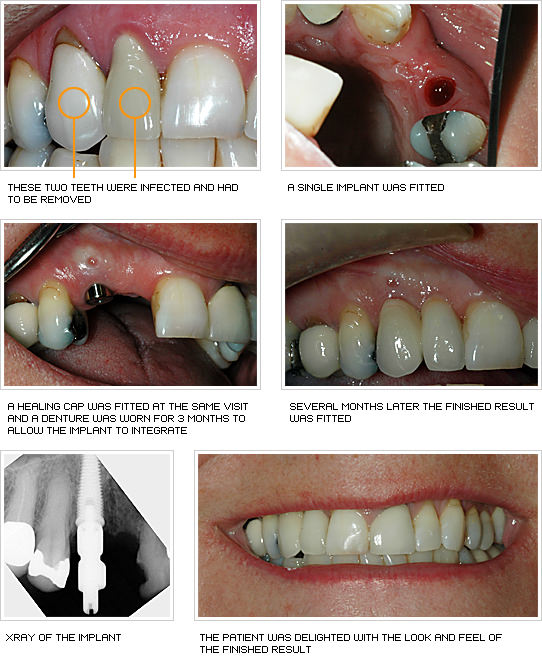The Greatest Guide To Dental Sense
The Greatest Guide To Dental Sense
Blog Article
Unknown Facts About Dental Sense
Table of ContentsHow Dental Sense can Save You Time, Stress, and Money.What Does Dental Sense Mean?Dental Sense Things To Know Before You BuyFascination About Dental Sense
are clinical tools operatively implanted right into the jaw to restore a person's capacity to chew or their look. They provide assistance for artificial (fake) teeth, such as crowns, bridges, or dentures. When a tooth is lost as a result of injury or condition, an individual can experience complications such as quick bone loss, faulty speech, or modifications to eating patterns that lead to discomfort.Oral implant systems contain a dental implant body and dental implant abutment and might also consist of an abutment fixation screw. Wisdom tooth cavity. The dental implant body is operatively put in the jawbone instead of the tooth's root. The oral implant joint is generally connected to the implant body by the abutment addiction screw and expands via gum tissues into the mouth to sustain the affixed synthetic teeth
(https://dentalsense1.mystrikingly.com/blog/transform-your-smile-with-dental-implants-root-canal-procedures-and)Structure of The Dental Implant System picking oral implants, speak with your oral supplier concerning the possible advantages and threats, and whether you are a prospect for the procedure. Points to take into consideration: Your overall health is a vital factor in establishing whether you are an excellent prospect for dental implants, exactly how long it will certainly take to heal, and how much time the dental implant might remain in location.
Cigarette smoking may influence the healing process and reduce the long-lasting success of the implant. The healing procedure for the dental implant body might take numerous months or longer, throughout which time you generally have a temporary abutment in place of the tooth. the dental implant treatment: Thoroughly adhere to the oral health directions given to you by your oral service provider.
Dental Sense - An Overview
Implant failure can lead to the need for another surgery to fix or change the dental implant system. Restores the capacity to chew Brings back aesthetic look Assists maintain the jawbone from reducing as a result of bone loss Preserves the health and wellness of the bordering bone and gums Assists maintain surrounding (nearby) teeth steady Enhances lifestyle Damage to surrounding natural teeth throughout dental implant positioning Injury to the surrounding cells throughout surgical treatment, such as sinus perforation Injury during surgical treatment (for instance, crack of bordering jawbone) Poor feature, such as seeming like the teeth do not attack together normally A sensation that the tooth hangs or twisting in position resulting from an abutment screw loosening up Implant body failing (looseness of the dental implant body) due to systemic infection, which might be more likely in clients with uncontrolled diabetes mellitus as a result of regional infection in bone and gums supporting the implant body because of delayed healing, which may be most likely in patients that smoke Trouble cleansing the periodontals around the implant, resulting in poor dental health Without treatment periodontal illness Post-surgical pins and needles due to nerve impingement or damage Constantly inform healthcare companies and imaging service technicians that you have dental implants before any type of magnetic resonance imaging (MRI) or x-ray procedures.
FDA is not conscious of any type of unfavorable occasions reported for MRI or x-ray treatments with dental implants. Oral implants systems are commonly made from materials that comply with global agreement criteria of the International Organization for Standardization (ISO) or ASTM International. These standards have information of what makes a safe product.

An oral implant is a structure that replaces a missing out on tooth. With screw-like devices, the surgeon inserts an implant into the jawbone, and it works as a support for a synthetic tooth, called a crown. A gadget called a joint attaches the man-made tooth to the dental implant. The crown is personalized to fit the person's mouth and match the shade of their teeth.
Getting My Dental Sense To Work
Some individuals are not qualified for dental implant surgical treatment. It is for dental specialists to operate people with: intense illnessuncontrollable metabolic diseasebone or soft cells condition or infectionIf these problems are fixed, a person can have the surgery. In, oral doctors abstain from operating individuals with: If individuals with any of the above undergo oral implant surgical treatment, there is a higher threat of the dental implant stopping working.

Oral dental implant surgical procedure is a customized process. It's not the exact same for every person. The following gives a general review of what you can expect your dental professional, oral specialist, periodontist or prosthodontist to do: Put the dental implant operatively. Provide you time to heal. Affix the post and final crown, bridge or denture.
Next, your cosmetic surgeon will carefully position the oral implant into your jaw. If your dental implant is near the front of your mouth, your dental practitioner will certainly make a temporary tooth for you to wear until you recover.
Rumored Buzz on Dental Sense
Your supplier can tell you what to anticipate in your scenario. During the recovery stage, your jawbone ought to fuse to the oral implant. This process, called osseointegration, is important for stability and long-lasting success. This process can take anywhere from 3 to nine months. In some cases, it may take much longer.
When your dental implant heals, your dental expert can affix the abutment (small port message) and your final reconstruction (crown, bridge or denture). This typically takes regarding one hour to finish and may require a 2nd small surgical procedure. You should not feel any type of discomfort throughout your oral implant treatment because your supplier will certainly use medication to numb your gum tissues.
Report this page